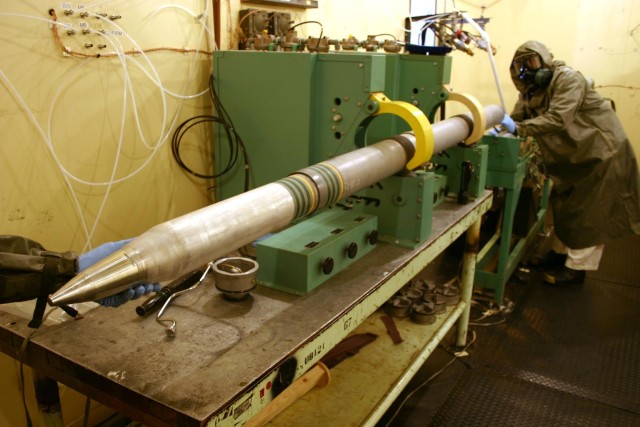ABERDEEN PROVING GROUND, Md. -- The U.S. Army Chemical Materials Agency, or CMA, announced that on July 1, 2010, it achieved the destruction of 75 percent of its chemical agent stockpile as defined under international treaty obligations.
"This accomplishment marks another extraordinary team effort between our storage and destruction staffs consisting of both government and contractor personnel," said CMA Director Conrad Whyne.
This accomplishment represents destruction efforts since Entry-Into-Force, when the United States ratified the Chemical Weapons Convention (CWC) treaty in April of 1997.
Also, 75 percent represents 22,958 tons of agent and more than 2.1 million munitions. CMA reached the 50 percent milestone in December of 2007 and the 60 percent destruction mark in April of 2009.
While not an official treaty-mandated achievement, 75 percent represents the ongoing progress the United States, under CMA's leadership, is making in fulfilling its international obligations to destroy the aging and obsolete chemical weapons stockpile.
CMA is on pace to meet the April 2012 deadline by destroying the 90 percent of the stockpile under its purview. The U.S. Army Element Assembled Chemical Weapons Alternatives (ACWA) program is responsible for destroying the remaining 10 percent under treaty.
In reaching the 75 percent destruction mark, CMA has also reduced the overall public risk from continued storage of the stockpile by 94 percent.
CMA's progress is reflected in the fact that neutralization sites at Aberdeen, Md., and Newport, Ind., as well as the incineration site at Johnston Atoll in the Pacific Ocean, have successfully destroyed their chemical warfare materiel stockpiles and are closed.
The four remaining CMA sites at Anniston, Ala.,; Pine Bluff, Ark.,; Tooele, Utah, and Umatilla, Ore., continue to use incineration, a proven safe and effective treatment, in accomplishing their mission. In addition, CMA's Non-Stockpile Chemical Materiel Project (NSCMP) has made substantial progress assessing and treating chemical materiel separate from the national stockpile.
NSCMP also beat the treaty deadline for destruction of the nation's chemical warfare production facilities and recently completed a mission at the Pine Bluff Explosive Destruction System site, destroying more than 1,200 recovered munitions.
"Our highly skilled government and contractor work force deserves a tremendous amount of credit for this achievement," Whyne continued. "We are another step closer to fulfilling one of our missions."
CMA remains committed to the safe and timely destruction of the nation's chemical agent and chemical warfare materiel. Final agent campaigns continue at CMA's remaining destruction sites - all four sites are destroying blister agent.
CMA continues to safely store chemical agent munitions at the ACWA sites near Richmond, Ky., and at Pueblo, Colo.
For more information about CMA, please visit www.cma.army.mil.


Social Sharing